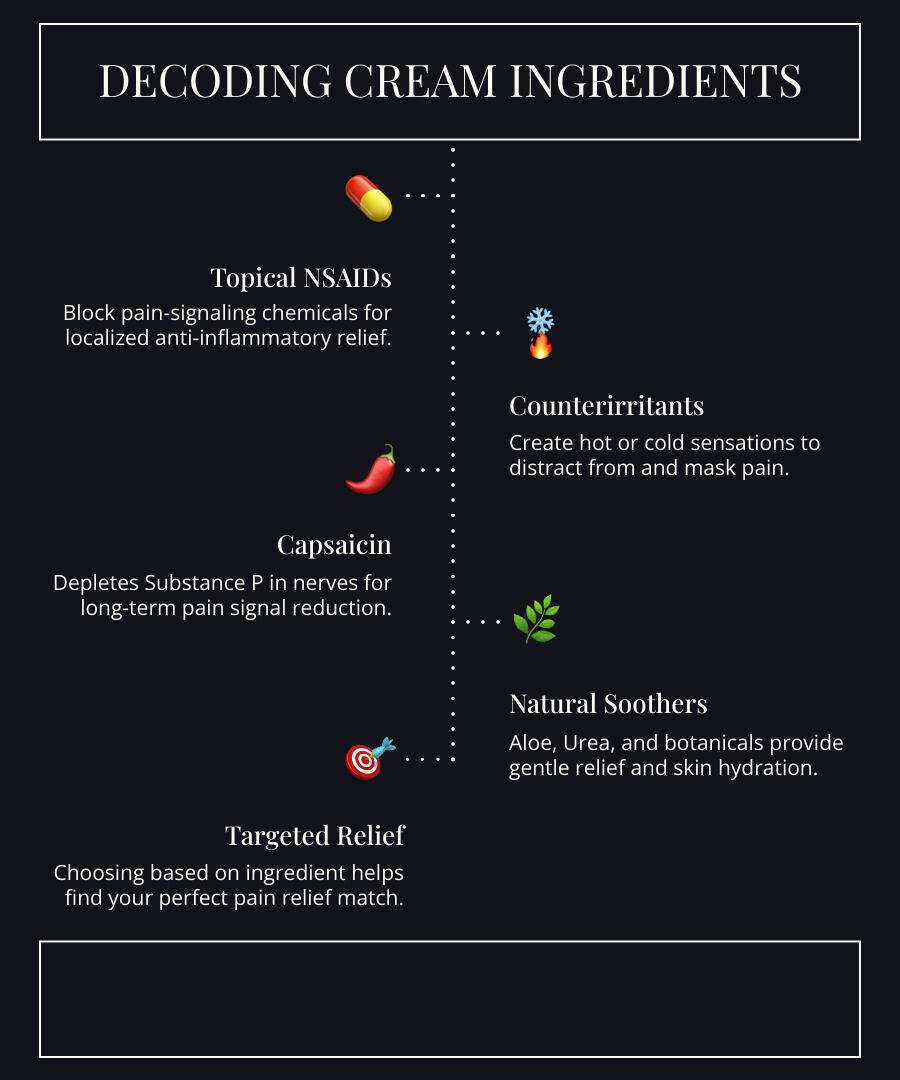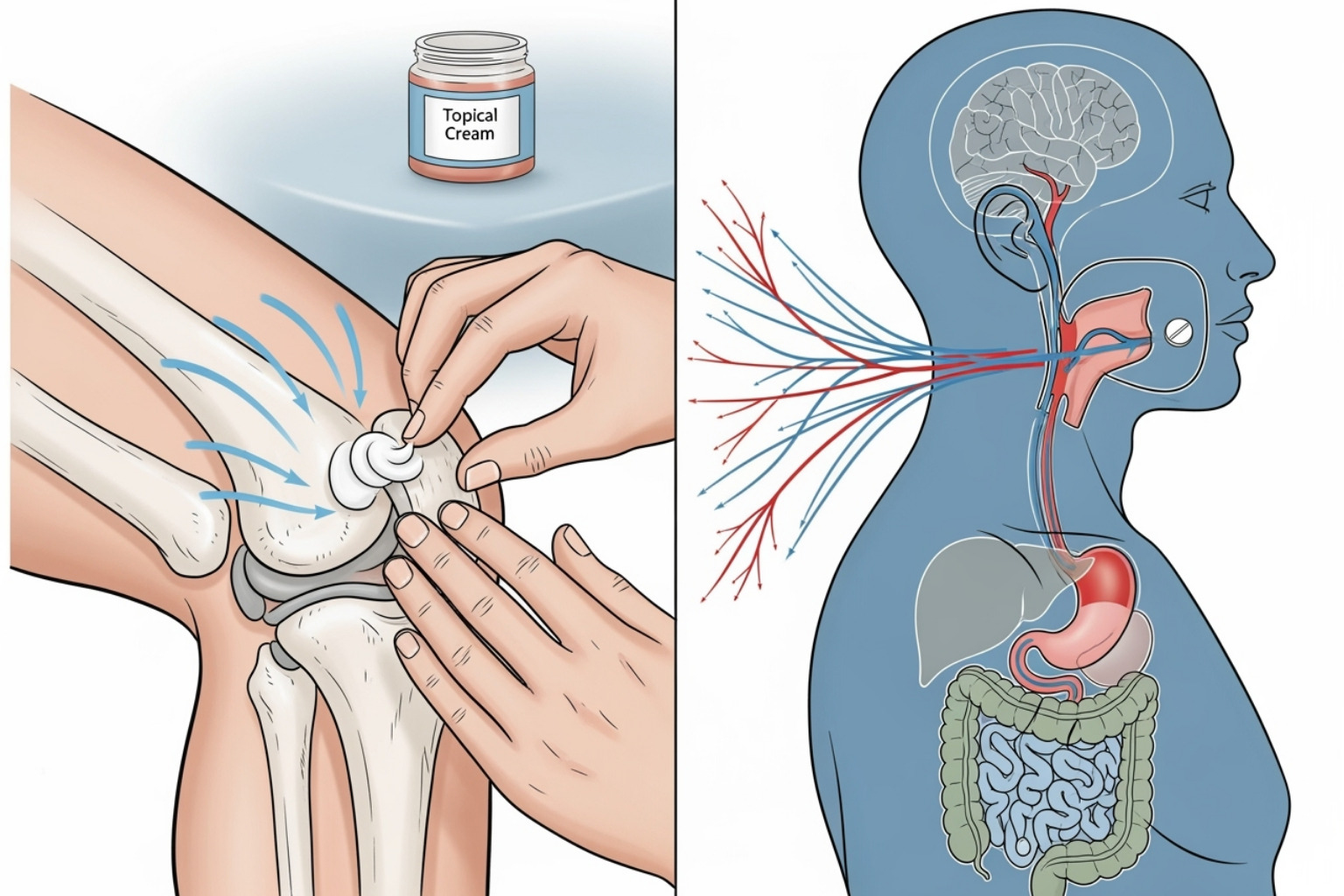Why Finding the Right Osteoarthritis Pain Relief Cream Matters
An osteoarthritis pain relief cream offers targeted, fast-acting relief for joint discomfort, often without the systemic side effects of oral medications. When your joints ache after a long day, a topical cream can dull the pain without requiring another pill.
The challenge isn't finding a cream—it's finding the one that works for you. Some cool the skin to distract from pain, while others penetrate deeper to block pain signals. Understanding the difference is key.
Top Options to Consider:
- Topical NSAIDs (Diclofenac): Highly effective for mild to moderate arthritis.
- Menthol-based creams: Provide fast-acting cooling relief.
- Capsaicin creams: A strong option for knee osteoarthritis, requiring consistent use.
- Natural formulas (Aloe, Urea, Menthol): Offer gentle, non-greasy relief for daily use.
Research, such as a 2020 review on topical diclofenac, shows that topical NSAIDs have extensive studies proving their efficacy and safety. They are particularly effective for joints close to the skin's surface, like hands and knees, and are often safer for older adults or those with heart or kidney concerns due to lower systemic absorption.
I'm Tony Enrico, and through my work developing Neuropasil's advanced pain relief formulations, I've helped thousands find effective solutions for joint discomfort. Our mission is to help 1 million people manage their pain by 2028. This guide will break down the science and help you choose the right cream for your specific needs.

Key osteoarthritis pain relief cream vocabulary:
Decoding the Active Ingredients in Osteoarthritis Pain Relief Creams
Not all osteoarthritis pain relief creams work the same way. Some cool your skin to distract from deeper aches, while others block pain signals at the source. Understanding the active ingredients helps you choose the right formula for your joint discomfort.
Counterirritants
Counterirritants work by creating a sensation on the skin that distracts your brain from deeper joint pain. Menthol triggers cold receptors for a cooling feeling, while camphor and methyl salicylate provide a warming sensation. This "hot and cold effect" essentially crowds out the pain signals from your osteoarthritis.
Found in brands like Bengay, Icy Hot, and Tiger Balm, they provide fast but temporary relief, making them great for moments when you need quick comfort. They are best for mild to moderate pain and do not address underlying inflammation.
Capsaicin
Derived from chili peppers, capsaicin works by depleting Substance P, a chemical that transmits pain signals from your joints to your brain. This process takes time and consistency. You may feel a burning sensation initially, but with regular application over two weeks, the nerve endings lose their ability to send pain messages.
A 2014 Cochrane review confirmed that capsaicin is particularly effective for knee osteoarthritis. Products like Capzasin-HP use this ingredient. If you try it, commit to the full two-week period. Always wash your hands thoroughly after application to avoid contact with your eyes or other sensitive areas.
Salicylates and Anesthetics
Salicylates are aspirin-like compounds that offer mild anti-inflammatory effects when applied to the skin. They can help reduce swelling and tenderness in affected joints and are found in some Aspercreme and Bengay formulas. If you are allergic to aspirin or take blood thinners, consult your doctor before using them.
Lidocaine is an anesthetic that numbs the area by blocking pain signals in the skin's nerve endings. It does not reduce inflammation but is effective for localized pain. A 2017 study published in the Journal of Pain Research found 5% lidocaine patches provided good relief for knee pain in patients with osteoarthritis. Brands like Salonpas often include lidocaine for targeted numbing.
Natural Soothing Ingredients
Many effective creams use plant-based compounds for a gentler approach. Aloe Vera soothes and moisturizes, while Urea hydrates the skin and can improve the absorption of other ingredients. These natural ingredients are ideal for sensitive skin and daily use.
At Neuropasil, our creams combine Aloe, Urea, and Menthol to deliver fast-acting relief that's gentle enough for daily use. The menthol provides immediate cooling, while Aloe and Urea keep the skin healthy. This synergy offers powerful relief without harsh chemicals or greasy residue, making it a favorite for customers with joint discomfort, nerve pain, muscle aches, and chronic conditions like fibromyalgia.
The Best Osteoarthritis Pain Relief Cream Options
Finding the "best" cream is a personal journey, but we've rounded up top-rated options, including our Neuropasil line, to help guide your choice.
Best Overall: Neuropasil Osteoarthritis Pain Relief Cream
For comprehensive, fast-acting relief, our Neuropasil osteoarthritis pain relief cream is a standout. We designed it to be your everyday ally against joint discomfort. Its unique blend combines the cooling power of menthol with the skin-nourishing benefits of Aloe Vera and Urea. This non-greasy formula absorbs quickly to soothe aching joints and ease muscle aches.
Our customers, from athletes to those with chronic pain, have found renewed comfort for everything from hand and knee pain to sciatica and plantar fasciitis. It's suitable for daily use, making it a cornerstone of your pain management routine.
Best for Sensitive Skin: Neuropasil Gentle Relief Formula
If you have sensitive skin, our Neuropasil Gentle Relief Formula is for you. This fragrance-free, hypoallergenic option is designed for comfort without irritation. It harnesses the soothing power of Aloe Vera and Urea to hydrate your skin while offering mild, effective pain relief.
Best for Persistent Pain: Neuropasil Extra Strength
For days when pain is particularly stubborn, our Neuropasil Extra Strength formula can help. It features a higher concentration of menthol for a more intense, deep-penetrating sensation to tackle persistent joint and muscle pains. It still includes our skin-friendly base of Aloe Vera and Urea, so you don't have to sacrifice skin health for stronger relief.
Best Natural Option: Neuropasil Plant-Based Cream
For those who prefer natural ingredients, our Neuropasil Plant-Based Cream is an excellent choice. It features carefully selected botanical extracts known for their soothing properties and is free from artificial fragrances or dyes—just pure, plant-powered relief for chronic discomfort.
While we're proud of our Neuropasil line, other solid options exist. Voltaren Arthritis Pain Gel (containing diclofenac) is a topical NSAID now available over-the-counter that targets pain and inflammation. Tiger Balm uses camphor and menthol for its signature cooling and warming sensations. Bengay Pain Relieving Cream combines salicylates with counterirritants. Icy Hot Vanishing Gel offers a similar effect with a scent that disappears. Aspercreme is available in odor-free salicylate and diclofenac versions. For those with patience, Capzasin-HP Arthritis Cream uses capsaicin to block pain signals over time.
Topical vs. Oral Pain Relief: Which is Right for You?
Choosing between an osteoarthritis pain relief cream and an oral pain medication involves understanding how each works and which best fits your health needs.
The Major Benefits of Topical Creams
Topical creams are applied directly to the source of pain, allowing active ingredients to work where you need them most. This targeted approach means less medication enters your bloodstream, leading to a significantly lower risk of systemic side effects.

Unlike oral NSAIDs (ibuprofen, naproxen) that can cause stomach upset, ulcers, or bleeding, topical NSAIDs like diclofenac gels are much gentler on your gastrointestinal system. They also place far less burden on your liver and kidneys, as confirmed by multiple studies. This makes topical creams a safer choice for many older adults or those with heart or kidney problems, a fact supported by research and institutions like the Mayo Clinic. Plus, many effective options are available over-the-counter.
When to Consider Oral Medications
Topical creams may not be the complete answer for everyone. If you have widespread pain affecting multiple joints, oral medications can be more practical as they work systemically. Severe inflammation or pain that interferes with daily activities may also require stronger, doctor-prescribed oral medications.
Creating a Holistic Pain Management Plan
The most successful strategies often combine multiple approaches. Use your topical cream for targeted relief while incorporating other therapies. Exercise strengthens muscles around the joints, physical therapy improves function, and weight loss can reduce stress on knees and hips.
By creating a personal "relief team"—combining topical creams, doctor-recommended medications, movement, and lifestyle adjustments—you can manage pain more effectively. No single solution has to do all the work. To learn more, see our guide to managing arthritis pain: a guide to long-lasting relief.
How to Use and Handle Your Osteoarthritis Pain Relief Cream
Getting the most from your osteoarthritis pain relief cream is simple, but following a few best practices can significantly improve your results.
Proper Application Guidelines
First and foremost, always read the product label for specific instructions on dosage and frequency.
- Prepare the Area: Apply the cream to clean, dry skin to ensure proper absorption and reduce the risk of irritation.
- Use the Right Amount: A thin, even layer is usually sufficient. Using more doesn't speed up relief and may increase side effects. For topical NSAIDs, use the included dosing card for accuracy.
- Wash Your Hands: Always wash your hands thoroughly after application, especially when using capsaicin creams, to avoid accidentally touching your eyes or other sensitive areas.
- Avoid Damaged Skin: Never apply pain relief cream to broken, irritated, or damaged skin, as this can cause severe irritation.
- Skip Extra Heat: Do not use a heating pad or tight bandages over the treated area, as this can cause burns or excessive irritation.
Special Considerations for Different Joints
Topical creams work best on joints close to the skin's surface, like the hands, wrists, knees, and ankles. For larger joints like the knees, ensure you cover the entire painful area. When treating hands, be mindful to wash them before preparing food or touching your face. Using disposable gloves for application is a smart way to protect your hands and prevent accidental transfer.
Understanding OTC vs. Extra Strength Creams
Over-the-counter (OTC) creams contain ingredients like menthol, camphor, and salicylates, and are ideal for mild to moderate pain. In recent years, former prescription-strength medications like diclofenac gel have become available OTC, offering a more potent option for moderate osteoarthritis pain.
Extra strength versions contain higher concentrations of active ingredients (e.g., more menthol) and are useful when regular strength isn't enough. It's best to start with the lowest effective strength and only increase if needed. Always consult a healthcare provider if you have underlying health conditions or take other medications.
Potential Side Effects and How to Manage Them
The most common side effects are skin irritation, redness, or a burning sensation, particularly with capsaicin. This often subsides with consistent use. If it's severe or persists, stop using the product. Allergic reactions (hives, rash, itching) are rare but require you to stop use immediately. If you experience an intense capsaicin burn, applying milk or mild soap can help neutralize it. While uncommon, topical NSAIDs carry a small risk of systemic side effects, so always follow label warnings.
When to See a Doctor About Your Joint Pain
While an osteoarthritis pain relief cream is an effective tool, it's not always the complete solution. Knowing when to seek professional medical advice is a key part of managing your health responsibly.
Topical treatments are excellent for managing everyday discomfort, but certain signs indicate your body needs more help. Recognizing these signals is crucial for your long-term well-being.
Key Warning Signs
It's time to call your doctor if you experience any of the following:
- Your pain worsens or doesn't improve after consistent use of a cream for the recommended time (e.g., 7-21 days for topical NSAIDs, 2 weeks for capsaicin).
- You develop severe side effects, such as blistering, a widespread rash, intense itching, or signs of an allergic reaction (hives, difficulty breathing).
- Your joint becomes red, swollen, and hot to the touch. According to the Arthritis Foundation, these may be signs of an infection or a different type of inflammatory arthritis, like gout or rheumatoid arthritis, which require specific medical treatment.
- The pain significantly interferes with your daily life, preventing you from working, sleeping, or participating in activities you enjoy.
- You develop a fever along with your joint pain, which could indicate a systemic infection or inflammatory condition.
Additionally, always consult your doctor before combining treatments, such as using multiple creams or mixing topical and oral medications, to avoid potential interactions.
Topical creams are intended for temporary relief of mild to moderate pain. If your symptoms are chronic, severe, or accompanied by these warning signs, a proper diagnosis is essential for creating a comprehensive and effective treatment plan.
Frequently Asked Questions about Osteoarthritis Pain Relief Cream
Here are concise answers to some of the most common questions we receive about osteoarthritis pain relief cream.
How quickly do arthritis creams work?
The speed of relief depends on the active ingredient:
- Counterirritants (Menthol, Camphor): Work within minutes, providing a cooling or warming sensation that distracts from pain.
- Topical NSAIDs (Diclofenac): According to product guidelines for brands like Voltaren, it may take up to 7 days of consistent use to build up in the joint tissue and effectively reduce inflammation.
- Capsaicin: Requires the most patience. It can take up to two weeks of regular, daily application to deplete pain-signaling chemicals and achieve its full effect.
- Natural Ingredients: Relief speed varies. Menthol provides rapid soothing, while ingredients like Aloe Vera offer more gradual, cumulative benefits for skin health.
Can I use more than one type of pain relief cream at the same time?
We generally do not recommend this without consulting your doctor. Combining different active ingredients on the same area can increase the risk of skin irritation or other adverse reactions. If one cream isn't providing enough relief, speak with a healthcare professional. They can help you find a stronger formulation or a safe combination of therapies, which might include using different creams at different times of the day.
Are these creams a cure for osteoarthritis?
No, there is currently no cure for osteoarthritis. It is a degenerative disease involving the breakdown of joint cartilage. Osteoarthritis pain relief creams are highly effective for managing symptoms—they reduce pain and inflammation, which improves mobility and quality of life. They are a powerful tool in a broader management strategy that should also include exercise, physical therapy, and weight management. These creams help you live well with osteoarthritis by allowing you to stay active and comfortable.
Conclusion: Finding Your Perfect Match for Joint Pain Relief

By now, you're equipped with the knowledge to find your ideal osteoarthritis pain relief cream, not just any cream. You understand the science, from the immediate distraction of a counterirritant to the inflammation-fighting power of a topical NSAID.
The beauty of topical relief is its targeted nature. You apply it exactly where it hurts, sparing your body the systemic risks associated with oral pain pills. This is a significant advantage, especially for older adults or those managing other health conditions.
Your perfect match depends on your unique needs. Whether you need fast, gentle relief for daily use, a stronger formula for persistent pain, or a natural, plant-based option, there is a solution for you. No osteoarthritis pain relief cream is a magic cure, but it is an essential tool for managing symptoms and improving your quality of life. These products work best as part of a holistic approach that includes exercise, physical therapy, and other doctor-recommended treatments.
At Neuropasil, our mission is to help you reclaim comfort and mobility. Our formulas combine fast-acting menthol with skin-healthy Aloe Vera and Urea in non-greasy creams you'll actually want to use. We've helped thousands find relief from osteoarthritis, nerve pain, muscle aches, and more, because we deliver what your body needs in a way that fits your lifestyle.
If your pain persists or you notice any warning signs, please consult your doctor. You deserve to move through your day without pain holding you back. With the right cream and a thoughtful approach to your health, you can take meaningful steps toward that goal.
Explore our solutions for targeted pain relief and find how Neuropasil can support your journey to greater comfort and freedom.
Sources
- Antonelli, M., et al. (2020). "Efficacy, safety and tolerability of Tiger Balm® ointments: a systematic review and a meta-analysis of prevalence." ResearchGate. https://www.researchgate.net/publication/336649980EfficacysafetyandtolerabilityofTigerBalmRointmentsasystematicreviewandameta-analysisofprevalence
- Arthritis Foundation. "Topical Pain Relief for Arthritis." https://www.arthritis.org/health-wellness/treatment/pain-relief/topical-creams
- Arthritis Foundation. "When to See a Doctor for Joint Pain." https://www.arthritis.org/health-wellness/treatment/joint-pain/when-to-see-a-doctor-for-joint-pain
- Gammaitoni, A. R., et al. (2017). "Lidocaine 5% patch for the treatment of knee pain in patients with osteoarthritis: post hoc analysis of a prospective, multicenter, open-label study." Journal of Pain Research. DOI: https://doi.org/10.2147/JPR.S122266
- Laslett, L. L., & Jones, G. (2014). "Capsaicin for osteoarthritis pain." Cochrane Database of Systematic Reviews. DOI: https://doi.org/10.1002/14651858.CD004246.pub3
- Mayo Clinic. "Pain medications: Know your options." http://www.mayoclinic.com/health/pain-medications/PN00041
- Revel, F. B. (2020). "Topical Diclofenac, an Efficacious Treatment for Osteoarthritis: A Narrative Review." Rheumatology and Therapy. DOI: https://doi.org/10.1007/s40744-020-00196-6
- U.S. Food and Drug Administration (FDA). (2020). "FDA Approves Three Drugs for Nonprescription Use Through Rx-to-OTC Switch Process." https://www.fda.gov/news-events/press-announcements/fda-approves-three-drugs-nonprescription-use-through-rx-otc-switch-process
- Voltaren Arthritis Pain Gel. "Frequently Asked Questions." https://www.voltarengel.com/faq/













